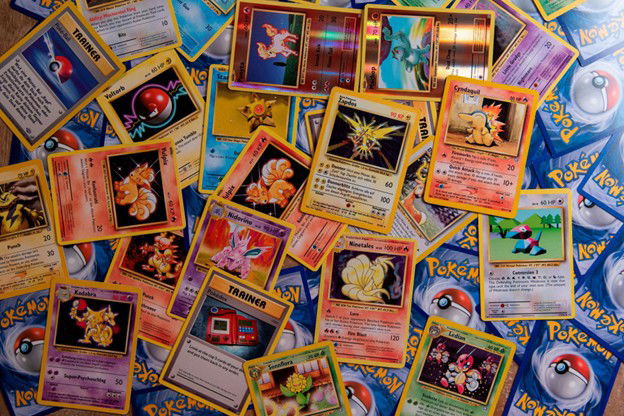A few years ago, they were being sold in schoolyards for a few cents; now, they are being auctioned for thousands, even hundreds of thousands, of dollars.
The increase has been meteoric, with some vintage cards increasing more than 3,800% over the past 20 years. This meteoric rise in value has made the Pokémon Trading Card Game (TCG) an unlikely yet powerful store of value for individuals operating as investors, collectors, or speculators.
Whether you're interested in tracking card values, market trends, or confirming the authenticity of cards, or would prefer a look at the vast casino gaming library and knowledge provided here on pegionline.eu, then we have got you covered.
The Emergence of Pokémon Cards as an Investment Asset Class
What started as a craze in the 90s has matured over time into a serious niche market. Originally published in Japan and subsequently exported worldwide, Pokémon cards became wildly popular among children and collectors. The development of limited-edition cards, holographics, and exclusive tournament participation opportunities fostered a scarcity-based subculture. As early collectors retained their cards - often in mint condition - a level of top graded cards began to appear in the resale market.
During the early 2010s, the prices of most Pokémon cards were relatively stable. It was not until 2020 that their market exploded. The impact of YouTube personalities and unboxing rare celebrity packs, combined with lockdowns during the pandemic, put Pokémon cards back into the spotlight. Shadowless Charizard, which a few years earlier was worth a few hundred dollars, now sells for tens of thousands. PSA-graded 10s of rare editions became the gold standard for investment portfolios.
Outperformance of Traditional Markets
The raw statistics are difficult to overlook. Some portfolios of Pokémon cards have experienced gains over the past 20 years of over 3,800%, which is well above the traditional benchmark investments, such as the S&P 500. Unlike equities, which are driven by earnings reports and regulations, Pokémon cards are influenced by supply, demand, nostalgia, and cultural relevance. Pricing is a result of scarcity, card condition, and what collectors feel.
First edition base set cards are now highly valued. When combined with professional grading, notably from services such as PSA or Beckett, prices skyrocket. As an example, a PSA 10 first edition Charizard, which could have been purchased for a few hundred dollars in the early 2000s, now routinely sells for six figures at auction.
Graded trading cards have become an appealing way for investors interested in diversifying their collections to buy alternatives, such as art, wine, or sneakers. Since Pokémon is a pop culture phenomenon with a global fan base, it is often the first project to jump-start this emerging industry.
Warning Signs: Is the Bubble About to Burst?
But with gigantic gains come enormous risk. Some industry analysts are warning that the Pokémon card market is heading into a speculative bubble. The symptoms are all too familiar: a rapidly rising price, an influx of inquisitive buyers buying blindly, and overleveraged speculators buying on the hope of continued growth. Many cards reached their peak price in 2021 and 2022, only to plummet months later when demand was met by supply.
What accounts for the market volatility of Pokémon is the combination of collectors and investors. Authentic collectors will have held onto their assets over time, developing a sentimentality and a desire for completeness in their collections. Investors, on the other hand, may be in for short-term gains, losing no time dumping cards once the prices begin to wane. This tug-of-war is unstable, and price movement can be sharp and extreme.
Another danger is associated with reprints and saturation. As new expansions and reprints of older favourites from The Pokémon Company keep pouring out, however, some cards may lose a bit of their mystique and scarcity value. Additionally, counterfeit cards have begun to flood the secondary marketplaces, making authentication more challenging and eroding buyer trust.
Market Awareness: Caution and Research
Despite the risks, many still view Pokémon cards as a potentially profitable long-term investment, provided due diligence is taken. Authentication, grading and provenance have become key elements of a safe transaction. Grade profiling services ensure some level of standardisation, but market cycles must also be taken into account.
Experienced forgers recommend purchasing what you love, rather than blindly speculating. Nostalgia can be a strong motivator, and owning pieces that speak to you directly can help smooth out market fluctuations and waves. For those who are purely investing, auction data, authentication and proper storage conditions are all essential.
As with any alternative asset class, diversification is essential. As seductive as Pokémon cards may be, they don't belong as a mainstay in any portfolio. Although these investments can complement traditional investments well, if you rely on them to continue increasing in the future, you will be setting yourself up for a major letdown.
A Market Still Evolving
The Pokémon card market is by no means dead. New generations continue to explore the franchise, and digital platforms like TCG Live and Pokémon TCG Pocket are expanding the ecosystem. The release of high-profile auctions and celebrity partnerships ensures that high-value cards remain in the spotlight, while advancements in packaging, design, and digital-to-physical connections are keeping the hobby fresh.
Ultimately, the evolution of Pokémon cards from a children's pastime to a financial phenomenon is one of the most unique stories in the history of modern collectables. Whether it keeps on growing or settles out, one thing is sure - Pikachu and friends have earned a permanent place not just in the pop culture pantheon, but in investment discussions all over the world.









— Commenti 0
, Reazioni 1
Diventa il primo a commentare